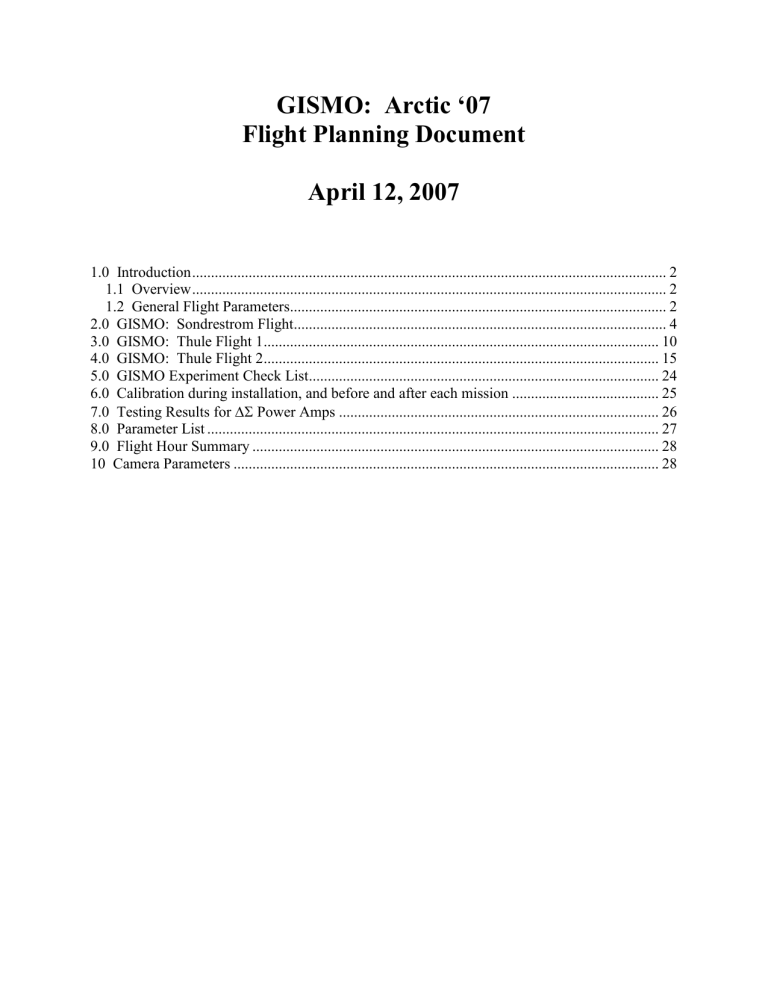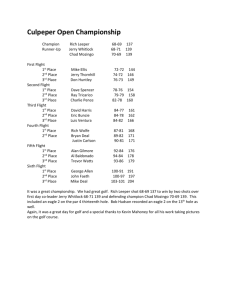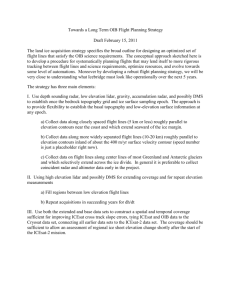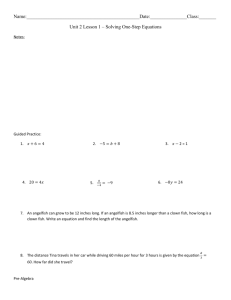GISMO_07_b - Byrd Polar and Climate Research Center

GISMO: Arctic ‘07
Flight Planning Document
April 12, 2007
Power Amps ..................................................................................... 26
1.0 Introduction
GISMO is a concept for a spaceborne radar system designed to measure the surface and basal topography of terrestrial ice sheets and to determine the physical properties of the glacier bed.
Our primary objective is to develop this new technology for obtaining spaceborne estimates of the mass of the polar ice sheets with an ultimate goal of providing essential information to modelers estimating the mass balance of the polar ice sheets and estimating the response of ice sheets to changing climate. Our technology concept employs VHF and P-band interferometric radars using a novel clutter rejection technique for measuring the surface and bottom topographies of polar ice sheets. Our approach will enable us to reduce signal contamination from surface clutter, measure the topography of the glacier bed, and paint a picture of variations in bed characteristics. The technology will also have applications for planetary exploration including studies of the Martian ice caps and the icy moons of the outer solar system. We have recently shown that it is possible to image a small portion of the base of the polar ice sheets using a SAR approach. Through the concept developed here, we believe that, for the first time, we can image the base and map the 3-dimenional basal topography beneath an ice sheet at up to
5 km depth..
1.1 Overview
During Arctic ’07, we plan to conduct airborne observations using the NASA P-3 aircraft over
Greenland. The planned flight lines are shown in figure 1. We will validate the following
GISMO objectives
1) relative backscatter strength at 150 and 450 MHz
2) determine maximum swath width for interferometry
3) demonstrate clutter rejection approaches (InSAR, tomography, multiaperture beam formation)
4) investigate mosaic formation over areas suspected to have a wet bed
5) acquire data over thick and thin ice
6) acquire calibration data over the ocean
7) acquire data over all snow zones.
1.2 General Flight Parameters
Flights at 150 MHz
Flights at 450 MHz
Speed 270 Knots
Flight elevation 26,000 ft above sea level (one leg of Sonde flight at 1500 ft above ice sheet surface)
Special targets should be located 400 left or right of the nadir track
Digital Camera Photography over select areas.
Figure 1. GISMO flight lines for Arctic ‘07
2.0 GISMO: Sondrestrom Flight
Overview
Objectives: Observations at two frequencies; Observations from thin to thick ice; Observations of Clutter zones and moulins; calibration site; all glacier facies.
Parameters
1 Sonde Flight at 150 MHz
1 Sonde Flight at 450 MHz
Speed 270 Knots
Outbound elevation 26,000 ft above sea level
Inbound elevation 1500 ft above ice sheet surface
Inbound flight line offset 100 m from outbound flight line
Special targets(Swiss Camp, GRIP, GISP) should be located 400 left or right of the nadir track
Events
Start at Sonde and climb to 26000 ft leg across ablation, wet and percolation facies
Traverse across Jacobshavn Clutter zone
Pass over Disko Bay for Calibration
Swiss Camp Race Track – 4-6 legs, 25 m spacing - not accurately represented on shape file
(opportunity to dump data during turns)
Northern Clutter Targets
Dry Snow Zones and on to GISP/GRIP
Outbound leg can end before GISP/GRIP if time is short.
Descend to 1500 ft above surface
Return leg at lower elevation (1500 ft)
Eliminate race track and extensive ocean calibration
Return leg deviates from Outbound leg by including flight segments down and then back up the
Jacobshavn Channel and over PSU sites.
Way-point list
Long
309.3
309.3
309.3
Lat Name
67 BGSF
67 BGSF
67 BGSF
313.9465 67.95465 KJ01
309.7974 69.40807 KJ02
309.2225 69.15037 KJ03
308.5632 69.13953 KJ04
306.6419 69.09326 KJ05
309.1128 69.47167 FIORD
310.5411 69.55282 NR1W
311.0259 69.61438 NR1E
311.1129 69.52979 SR1E
310.6299 69.46824 SR1W
310.5413 69.55261 NR2W
311.0262 69.61417 NR2E
311.1131 69.52958 SR2E
310.6302 69.46803 SR2W
310.5415 69.5524 NR3W
311.0264 69.61396 NR3E
311.1133 69.52937 SR3E
310.6304 69.46781 SR3W
310.5418 69.55219 NR4W
311.0266 69.61375 NR4E
311.1135 69.52916 SR4E
310.6306 69.4676 SR4W
311.4171 69.75886 JS01
308.9572 71.75833 KJ07
308.3894 72.20556 KJ50
321.5356 72.58109 GISP4N
322.3626 72.58161 GRIP4N
322.3626 72.58071 GRIP4NF
321.5358 72.58019 GISP4NF
308.3896 72.20467 KJ50F1
308.3921 72.20589 KJ50F2
308.9599 71.75867 KJ07F1
308.9599 71.75868 KJ07F2
311.4194 69.75921 JS1F1
313.1318 69.39667 C4B
312.4069 69.29411 C4A
311.7932 69.22072 JAK01
310.5811 69.10772 JAK02
310.3009 69.17171 JAK03
309.6568 69.20253 JAK04
310.3009 69.17171 JAK03
310.5811 69.10772 JAK02
311.0258 69.15135 PSU4S
311.7932 69.22072 JAK01
311.8029 69.18056 C4
311.5004 68.84767 KJ099F
313.9481 67.95529 KJ01F1
313.9476 67.95385 KJ01F2
309.3011 66.9992 BGSFF
Photography (following the way point list above) (See Camera Parameters Section)
Can be done on either the 450 or 150 MHz flight depending on cloud. Only one observation is needed.
Outbound 26000 ft Elevation
Sensor length set to 15 mm
F = 18 mm
Interval = 31 sec
Camera On for Segments Connecting:
BGSF to NR1W
NR1W to NR1 E
NR1E to SR1 E
SR1E to SR1 W
SR1 W to NR2W
Camera off
Camera on
SR4W to KJ50
Camera off
Return flight 1500 ft elevation above surface
Sensor Length set to 15 mm
F = 18 mm
Interval = 2.5 sec
Camera on
KJ50 to KJ07 (+20 km)
Camera off
Camera on
C4b to C4
Camera off
Figure 1. Sonde outbound yellow dots: cities; red dots: field camps; Blue dots: places where
Prasad has identified clutter
Figure 2. Sonde flight details around Jacobshavn
Figure 3. Surface and bottom topography along the flight line (wgs-84)
3.0 GISMO: Thule Flight 1
Overview
Objectives: Observations at two frequencies; Repeat May 06 flight line; Observations from thin to thick ice; Open water calibration; Image NGRIP site; Subglacial water zones; mosaic images over North East Ice Stream all snow facies
Parameters
1 Flight at 150 MHz
1 Flight at 450 MHz
Speed 270 Knots
Flight elevation 26,000 ft
Special targets(NGRIP, NASA East) should be located 400 left or right of the nadir track
Flight includes a minimum of 3 parallel lines, separated by 2 km an passing over the North East
Ice Stream.
Events
Begin at Thule and climb to 26000 ft
Proceed Towards GITS along the May 06 Route towards
Proceed towards North East Ice Stream; execute 3 parallel lines starting between coordinates
(opportunity to dump data during turns)
Continue on to NASA East
Turn Towards NGRIP
Pass Over NGRIP
Return along outlet glaciers starting at
Fly down outlet Harold Moltke glacier (pending flight clearance)
Return towards Thule
Open Water Cal
Options: If time is short, turn towards NGRIP before reaching NASA East. If time is available add more mosaicking lines across the North East Ice Stream
Long
291.3
291.3
291.3
Lat Name
76.53 BGTL
76.53 BGTL
76.53 BGTL
299 77.19 CC
304.5167 77.0833 KJ
310.0163 76.85713 HWAY
323.4138 75.85639 PLMW
325.2996 75.64067 PLME
325.2688 75.62438 PLSE
323.3826 75.8401 PLSW
323.445 75.87268 PLNW
325.3303 75.65695 PLNE
330.0053 75.00333 NASE4N
317.9411 75.08861 NGNEW
317.7004 75.1036 NGRP4N
301.1447 76.23083 KJ50
296.7031 76.644 KJ51
294.2619 76.66867 KJ52
294.0215 76.64921 KJ53
293.3394 76.57861 HM01
292.8222 76.51732 HM02
292.4753 76.55894 HM03
292.3002 76.59096 HM04
291.8601 76.61913 HM05
288.1344 76.45833 OW
291.3 76.53 BGTL
Photography (following the way point list above) (can be done on either the 150 or 450 MHz flight depending on cloud)
26000 Ft
Sensor length set to 15 mm
F = 18 mm
Interval = 31 sec
Camera on
BGTL to CC
Camera off
Camera on
PLMW to PLME
Camera off
Camera On
KJ50 to BGTL
Camera off
Figure 1. Thule Flight 1. Red line is the May 06 route. Yellow dots: cities; red dots: field camps and clutter. Three lines, spaced 2 km apart will be used to mosaic scenes over the North
East Ice Stream (arrow)
Figure 2. Lines for image mosaic over Northeast Ice Stream.
Figure 3. Surface and bottom topography
4.0 GISMO: Thule Flight 2
Overview
Objectives: Observations at two frequencies; Observations from thin to thick ice; Open water calibration; Race Track over Mt. Gogineni; Clutter Sites; Peterman Glacier and Ice Shelf;
Subglacial water zones; all snow facies
Parameters
1 Flight at 150 MHz
1 Flight at 450 MHz
Speed 270 Knots
Flight elevation 26,000 ft
Special targets(GITS, NEEM, Mt. Gogineni, Humboldt) should be located 400 left or right of the nadir track
Events
Begin at Thule and climb to 26000 ft
Proceed over GITS
Proceed over NEEM
Turn Northeast and then on to North Clutter Site
Cross Northern Crevasse Zone
Pass down Petermain Glacier
Excecute Mt. Gogineni Race Track, 25 m spacing, 4 passes minimum. One leg offset 400 m from these points
Parallel leg should be located to the East of these points. Opportunity to dump data during turns.
Pass over Humboldt Camp
Return towards Thule
Open Water Cal
Options: Increase number of legs in Mt Gogineni race track if time permits. If time is short, head northeast from Neem to a point west of Nclutter to decrease total distance.
291.3
291.3
291.3
299
76.53 BGTL
76.53 BGTL
76.53 BGTL
77.19 CC
309.1023 77.49644 NEEM4S
310.984 77.52594 KJ3
330.5673 81.02071 KJ4
327.777 81.101 NCLUT
311.0761 81.18278 NCZ1
309.135 80.84722 NCZ2
303.0334 80.90015 ATMC39
298.486 81.18356 ATMC38
298.154 81.1187 ATMC15
299.27 80.7199 ATMC14
301.66 80.3038 ATMC13
307.5307 79.56843 WR1N
308.0907 79.33823 WR1S
308.5424 79.37452 ER1S
307.9804 79.60471 ER1N
307.5296 79.56833 WR2N
308.0896 79.33814 WR2S
308.5412 79.37443 ER2S
307.9793 79.60462 ER2N
307.5285 79.56824 WR3N
308.0885 79.33805 WR3S
308.5401 79.37433 ER3S
307.9782 79.60453 ER3N
307.5273 79.56815 WR4N
308.0873 79.33796 WR4S
308.539 79.37424 ER4S
307.9771 79.60444 ER4N
303.1825 78.74836 HUMB4S
295.6888 77.17829 KJ1
292.4058 76.66162 KJ2
288.2217 76.60778 OW2
291.3 76.53 BGTL
Photography (following the way point list above) (can be done on either the 150 or 450 MHz flight depending on cloud)
26000 Ft
Sensor length set to 15 mm
F = 18 mm
Interval = 31 sec
Camera On
NEEM (+- 20 km)
Camera off
Camera on
KJ4 to ATMC13
Camera off
Camera on (once around the raceway)
WR2N to WR2S to ER2S to ER2N
Camera off
Camera on
KJ1 to BGTL
Figure 1. Thule Flight 2. Yellow dots: cities; red dots: field camps and clutter. Mt Gogineni
Race track location is also shown.
Figure 2. Race Track near Mt. Gogineni.
Figure 3. Surface and bottom topography along the flight line (wgs-84)
Figure 4. Mount Gogineni
Figure 5. Mount Gogineni 3
Figure 6. Northern Clutter
5.0 GISMO Experiment Check List
Complete preflight briefing with pilots
Antennas properly configured
Pre flight Calibration completed (see calibration procedures sheet)
Radar Parameters Checked (see Parameters list)
GPS System Working and Recording Data
Inflight data validation via A-scope inspection and InSAR processing
Open Water Calibration data acquired
Post-flight calibration
Data downloaded and backed up.
Post flight data analysis via InSAR processing
Copy all data logs
Identify successful photo runs and identify regions for repeat try
6.0 Calibration during installation, and before and after each mission
During Installation:
We need to perform four types of calibrations:
1) Inject transmitter signal into each receiver through a known length of delay line and attenuation, and measure each receiver response.
2) Measure chirp waveform and record it.
3) Measure time delay from the rack to each antenna using a network analyzer.
4) Measure system response by flying over the ocean.
During a mission:
1) Record transmitter chirp waveform at the start and end of each mission, and during the mission on a disc with an oscilloscope.
This would probably require a directional coupler with 60-dB coupling coefficient with the coupled-port connected to an oscilloscope. The trigger to generate the chirp must be used to trigger the oscilloscope and data are recorded by the operator on disc. This task can be handled by the new RF engineer.
2) Fly over the ocean to collect data over a distance of 10-20 km before and after each mission.
7.0 Testing Results for
Power Amps
The two power amplifiers for the 450 MHz band of the GISMO radar were tested by applying a pulsed RF signal at the input of each module, and recording the corresponding output on a spectrum analyzer. The pulsed (TTL) gating signal was set to 2 kHz with a duty cycle of 20%
(pulse width 100us). These are testing parameters suggested by the manufacturer. The RF input tone was supplied by an HP8648D generator operating at a frequency of 450 MHz. The output power was monitored with the spectrum analyzer triggered by the same 2 kHz TTL gating signal.
A plot of the output power (Pout) as a function of input power (Pin) for the amplifiers appears in
Fig. 1. The effect of the attenuator chain placed at the output of the amps, as well as cable losses were calibrated out of the measurement. Both units (designated PA1 and PA2, respectively) are linear up to about 8 dBm of input power, after which saturation effects are noticeable. Dr. Allen pointed that this is acceptable as long as the units are able to produce Pout=2kW. The measured values of Pout for an input power of +17dBm are 63.7 dBm and 63.3 dBm for PA1 and PA2, respectively. These figures agree with the settings reported by
(slightly larger than 63 dBm for both units).
Both units were left ON for about 1 hr, with Pin= 17 dBm. No significant power change was visible at the output.
75
70
50
45
40
35
65
60
55
PA1
PA2
Linear extrapolation
30
-22 -20 -18 -16 -14 -12 -10 -8 -6 -4 -2 0 2 4 6 8 10 12 14 16 18
Pin [dBm]
Fig. 1. Recorded output power as a function of input power for the 450 MHz
power amps.
8.0 Parameter List
Parameters
Carrier frequency
Sampling frequency
Chirp_start_freq (IF)
Chirp_Stop_freq (IF)
Pulse_duration
PRF
Range_samples
Echo_delay
May 2006
150 MHz
150 MHz
120 MHz
20 MHz
40 MHz
3 us
14992.5 Hz
Number of waveforms
Number of transmit channels
Number of receive channels 6
Trasmit Power (high elevation)
Transmit Power (low elevation
4672
3.5 us / 14 us
4
2
April 2007
150 MHz
150 MHz
120 MHz
20 MHz
40 MHz
10 us
10000 Hz
4672
1.5 us
1
1
April 2007
450 MHz
450
5
1 kW (2 kW max) 1 kw (2 kW max)
200 W 200 W
9.0 Flight Hour Summary
Flight line total time
(hours) data collection time
(hours)
Thule 2 6.6 5.4
Thule 1 5.1 4.8
Sonde
2 flights per line
7.4
38.2
6.6
33.6
10 Camera Parameters
Sensor length = 22.5 m
Distance Spacing
H=26000
(km) (km)
F=18 mm 7.25
F=55 mm 2.37
H=1500
F=18 mm 0.57
F=55 mm 0.19
6.53
2.14
0.57
0.17
Interval
(sec)
47
15
3.7
1.2
Sensor Length = 15 mm
Distance Spacing
(km) (km)
4.83
1.58
0.38
0.13
4.35
1.42
0.35
0.11
Interval
(sec)
31
10
2.5
0.8






